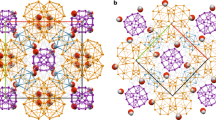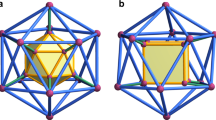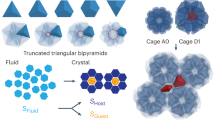Abstract
Self-assembled structures having a regular hollow icosahedral form (such as those observed for proteins of virus capsids) can occur as a result of biomineralization processes1, but are extremely rare in mineral crystallites2. Compact icosahedra made from a boron oxide have been reported3, but equivalent structures made of synthetic organic components such as surfactants have not hitherto been observed. It is, however, well known that lipids, as well as mixtures of anionic and cationic single chain surfactants, can readily form bilayers4,5 that can adopt a variety of distinct geometric forms: they can fold into soft vesicles or random bilayers (the so-called sponge phase) or form ordered stacks of flat or undulating membranes6. Here we show that in salt-free mixtures of anionic and cationic surfactants, such bilayers can self-assemble into hollow aggregates with a regular icosahedral shape. These aggregates are stabilized by the presence of pores located at the vertices of the icosahedra. The resulting structures have a size of about one micrometre and mass of about 1010 daltons, making them larger than any known icosahedral protein assembly7 or virus capsid8. We expect the combination of wall rigidity and holes at vertices of these icosahedral aggregates to be of practical value for controlled drug or DNA release.
This is a preview of subscription content, access via your institution
Access options
Subscribe to this journal
Receive 51 print issues and online access
$199.00 per year
only $3.90 per issue
Buy this article
- Purchase on Springer Link
- Instant access to full article PDF
Prices may be subject to local taxes which are calculated during checkout




Similar content being viewed by others
References
Thompson, D. W. On Growth and Form (Cambridge Univ. Pres, Cambridge, 1961).
Kimoto, K. & Nishida, I. The crystal habits of small particles of aluminium and silver prepared by evaporation in clean atmosphere of argon. J. Appl. Phys. 16, 941–948 (1966).
Hubert, H. H. et al. Icosahedral packing of B12 icosahedra in boron suboxide. Nature 391, 376–378 (1998).
Sackmann, E. & Lipowsky, R. Handbook of Biological Physics Vol. 1B (ed. Hoff, A. J.) (North-Holland, Amsterdam, 1995).
Kaler, E. W., Murthy, A. K., Rodriguez, B. E. & Zasadzinski, J. A. N. Spontaneous vesicle formation in aqueous mixtures of single-tailed surfactants. Science 245, 1371–1374 (1989).
Dubois, M. & Zemb, T. Swelling limits for bilayer microstructures: the implosion of lamellar structure versus disordered lamellae. Curr. Opin. Colloid Interf. Sci. 5, 27–37 (1997).
Wals, J. et al. Tricord protease exists as an icosahedral supermolecule in vivo. Molecul. Cell. 1, 59–65 (1997).
Klug, A., Franklin, R. E. & Humphrey-Owen, S. P. F. The crystal structure of Tipula iridescent virus as determined by Bragg reflection of visible light. Biochem. Biophys. Acta 32, 203–219 (1959).
Dubois, M., Gulik-Kryzwicki, Th., Demé, B. & Zemb, T. Rigid organic nanodiscs of controlled size: A catanionic formulation. C. R. Acad. Sci. Paris II C 1(9), 567–575 (1998).
Scamehorn, J. F. & Hartwell, J H. in Surfactant Science Series (eds Scamehorn, J. F. & Harwell, J. H.) Vol. 33, Ch. 10 (Marcel Dekker Inc., New York, 1989).
Graciaa, A., Ghoulam, M. B., Marion, G. & Lachaise, J. Critical concentrations and compositions of mixed micelles of sodium dodecylbenzesulfonate, tetradecyltrimethylammonium bromide and polyethylenephenols. J. Phys. Chem. 93, 4167–4173 (1989).
Schnur, J. Lipid tubules: a paradigm for molecularly engineered structures. Science 262, 1669–1675 (1993).
Thomas, B. N., Safinya, C. R., Plano, R. J. & Clark, N. A. Lipid tubules self-assembly: length dependence on cooling rate through a first-order phase transition. Science 227, 1635–1638 (1995).
Parente, R. A., Höchli, M. & Lentz, B. R. Morphology and phase behavior of two types of unilamellar vesicles prepared from synthetic phosphatidylcholines studies by freeze-fracture electron microscopy and calorimetry. Biochim. Biophys. Acta 812, 493–502 (1985).
Regev, O., Marques, E. F. & Khan, A. Polymer-induced structural effects on catanionic vesicles: formation of faceted vesicles, disks, and cross-links. Langmuir 15, 642–645 (1999).
Zemb, T., Dubois, M., Demé, B., Gulik-Krzywicki, T. Self-assembly of flat nanodiscs in salt-free catanionic surfactant solutions. Science 283, 816–820 (1999).
Hyde, S. T. Topological transformations mediated by bilayer punctures: from sponge phases to bicontinuous monolayers and reversed sponges. Colloids Surf. A 129–130, 207–225 (1997).
Fogden, A., Daicic, J. & Kidane, A. Undulating charges in fluid membranes and their bending constants. J. Phys. (Paris) II 7, 229–248 (1997).
Fogden, A. & Daicic, J. & Kidane, A. Bending rigidity of ionic surfactant interfaces with variable charge density: the salt-free case. Colloids Surf. A 129–130, 157–165 (1997).
Nelson, D. R. & Spaepen, F. Polytetrahedral order in condensed matter. Solid State Phys. 42, 1–90 (1989).
Dubois, M., Belloni, L., Zemb, T., Demé, B. & Gulik-Krzywicki, T. Formation of rigid nanodiscs: Edge formation and molecular separation. Prog. Colloid Polym. Sci. 115, 238–242 (2000).
Radtchenko, I. L. et al. Assembly of alternated mutlivalent ion/polyelectrolyte layers on colloidal particles. Stability of the multilayers and encapsulation of macromolecules into polyelectrolyte capsules. J. Colloid Interf. Sci. 230, 272–280 (2000).
Donath, E., Sukhorukov, G. B., Caruso, F., Davis, S. A. & Möhwald, H. Novel hollow polymer shells by colloid-templated assembly of polyelectrolytes. Angew. Chem. Int. Edn 37, 2202–2205 (1998).
Spector, M. S. & Zasadsinski, J. A. Topology of multivesicular liposomes, a model biliquid foam. Langmuir 12, 4704–4708 (1996).
Klug, A. & Caspar, D. L. D. The structure of small viruses. Adv. Vir. Res. 7, 225–325 (1960).
Crick, F. H. & Watson, J. D. The structure of small viruses. Nature 177, 473–475 (1956).
Acknowledgements
We thank G. Sukhorukov and O. Tiourina for help in confocal optical microscopy, and I. Erk for cryo-TEM. We also thank J.-L. Sikorav, P. Timmins and B. W. Ninham for critical reading of the manuscript and suggestions.
Author information
Authors and Affiliations
Supplementary information

Fig. S1 (GIF 14 KB)
Differential scanning calorimetry (DSC) of a catanionic mixture taken at a heating rate of 2°C/min at initial mole ratio r= 0.6. The chain melting transition is located at Tf= 50°C.

Fig. S2 (GIF 12 KB)
Schematic phase diagram showing the formation path of icosahedra (partial diagram for Φ 0.10). Above the chain melting temperature, stable unilamellar vesicles are formed for volume fractions in the range 0.1% to 1%. For the same composition, this sample is in a biphasic domain at room temperature. Tie lines between a lamellar phase with cristallised bilayers (Lβ) and nearly pure water (W) are shown. The "water" phase contains of the order of 1mmole of charged surfactant and the excess counter-ions, as shown by conductivity measurements. Slow cooling towards room temperature induces a liquid-liquid phase separation between a Lβ and a large volume of optically isotropic flowing solution which contains dispersed icosahedra (ICO). The surfactant volume fraction is of the order of Φ = 10-3. At rest and room temperature, icosahedra slowly flocculate after a few months following the tie-lines. These equilibrium lines connect the water corner to the Lβ phase at maximum swelling.

Fig.S3 (GIF 15 KB)
Wide angle scattering shows the in-plane distribution of deuterated chains in the Lβ phase in equilibrium with icosahedra (volume fraction 10%). (H/D) designs mixed deuterated anionic and protonated cationic surfactant at a molar ratio r = 0.65. (H/H) corresponds to a sample of same composition, but containing only hydrogenated chains. The main sharp peak corresponds to the frozen hydrocarbon chains in Lβ configuration (qf = 1.52 Å-1), whereas a broad superstructure peak appears around qf= 1.52/√3, showing the local hexagonal alternated packing. The superstructure peak is broad, showing defects in the triangular tiling, consistently with the quasi-equivalence principle.

Fig. S4 (JPG 4 KB)
Optical confocal microscopy images taken with an oil immersion objective (Leica TCS SP, excitation wavelength 525 nm), using a cationic dye (Rhodamine 6G). Left is the transmission micrograph. Two other images are confocal cuts through the same object obtained by displacing the focal plane by steps of 0.5 mm. Vertices are preferentially coloured by the positively charged dye molecule. This is an indication that excess anionic component is more pronounced around the vertices of the icosahedra. Central vertix can be seen on the top of the object, five-fold symmetry on the second cut. Distances between vertices are close to microscope resolution.

Fig. S5 (JPG 16 KB)
Electron micrographs of microstructures obtained not enough (A) or when too much (B) excess anionic surfactant is present to form icosahedra. (A) Fragments coexisting with closed objects are observed when r=0.52. Near equimolarity, there is not enough myristic acid to form the required minimal number of pores per vesicle. Some aggregates than fragment into nanodiscs upon cooling. (B) Large planar structures decorated with holes do not fold into closed objects when r=0.65. Micrographs show the coexistence of flat fragments with some facetted vesicles (bar is 1µm)
Rights and permissions
About this article
Cite this article
Dubois, M., Demé, B., Gulik-Krzywicki, T. et al. Self-assembly of regular hollow icosahedra in salt-free catanionic solutions. Nature 411, 672–675 (2001). https://doi.org/10.1038/35079541
Received:
Accepted:
Published:
Issue Date:
DOI: https://doi.org/10.1038/35079541
This article is cited by
-
One-step procedure for the preparation of functional polysaccharide/fatty acid multilayered coatings
Communications Chemistry (2019)
-
Synthesis of amphiphilic V-type silica nanogels and study of their self-assembling at the air–water interface
Russian Chemical Bulletin (2018)
-
Formation of non-spherical polymersomes driven by hydrophobic directional aromatic perylene interactions
Nature Communications (2017)
-
Giant capsids from lattice self-assembly of cyclodextrin complexes
Nature Communications (2017)
-
A route to self-assemble suspended DNA nano-complexes
Scientific Reports (2016)
Comments
By submitting a comment you agree to abide by our Terms and Community Guidelines. If you find something abusive or that does not comply with our terms or guidelines please flag it as inappropriate.



